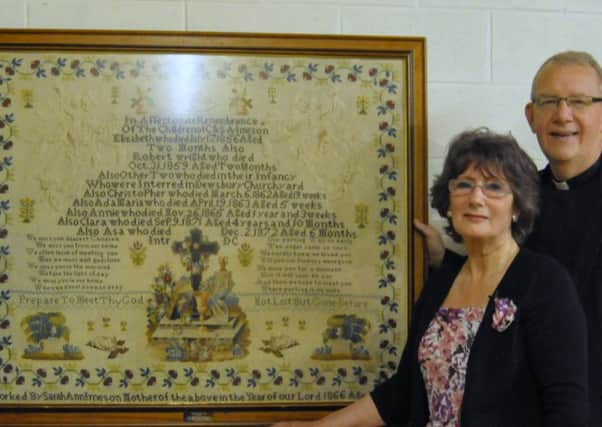Tragic story behind restored Dewsbury tapestry


It was saved and restored by journalist Margaret Watson who this week presented it to the church.
The tapestry was created 150 years ago by Sarah Ann Imeson in memory of nine of her children who died in infancy between 1855 and 1871.
Advertisement
Hide AdAdvertisement
Hide AdThe names of the children as well as where they were born and buried are embroidered on this unique piece of art.
Sarah Ann and her husband, Christopher Imeson, moved to Dewsbury in 1855 at the height of the Industrial Revolution.
Christopher had been a farm labourer on the Studley Farm Royal Estate in Ripon and Sarah Ann a servant at Arlington House in Knaresborough.
The couple moved to Dewsbury for a better life but nothing could have prepared them for the sorrows to come.
Advertisement
Hide AdAdvertisement
Hide AdFor within months of arriving in Dewsbury, Sarah Ann would give birth to twins, a boy and a girl, who would not survive.
The boy, who was born at lunchtime, lived only 40 minutes and would be in his grave by teatime, sharing a coffin with a stranger being buried that day.
His father would register both his birth and death on the same day at Dewsbury Register Office.
The little girl born that day had given hope to Sarah Ann and Christopher for she had lived for seven weeks.
Advertisement
Hide AdAdvertisement
Hide AdBoth children were buried in Dewsbury Parish Churchyard in graves which bore no headstone.
Sarah Ann was to give birth to nine more children, but only two would survive – Arthur and Amy, who mercifully grew to maturity, married and outlived their parents.
Arthur, who had five children, died in 1935 aged 66.
Amy who had no children, died in 1934 aged 61.
Sadly, two of Arthur’s children would also die in infancy, but there was joy to follow when his wife, Elizabeth (née Coldwell) eventually gave birth to three healthy children – Wilf, Dorothy and Alec.
They all grew to maturity but sadly none of them had children to whom the tapestry could be passed on.
Advertisement
Hide AdAdvertisement
Hide AdYet another great tragedy was to befall the Imeson family when in 1935 Arthur took his own life by drowning in a mill dam at the age of 66.
The dam belonged to Joshua Ellis’ in Batley Carr, where he worked as a foreman in the weaving department.
His wife told the coroner that Arthur had been worried about his health following an operation.
The inquest concluded he had committed suicide while in a fit of depression owing to ill-health.
Advertisement
Hide AdAdvertisement
Hide AdThe blood-line of Sarah and Christopher ended in 1964 with the death of their youngest grandchild Alec, who was living in Bristol at the time.
Last week the tapestry was presented to the Minster Church by Margaret and unveiled by John Flowers, a descendant of the Imeson family on Christopher’s side.
John and his cousin, Perry Exley, of Winnipeg, Canada, have helped Margaret enormously over the years in her research on the tapestry.
They still continue to do so and have presented a book to the Minster containing all their findings, including a family tree of the Imeson family going back many generations.
Advertisement
Hide AdAdvertisement
Hide AdThe unveiling ceremony was organised by the Mother’s Union which has been doing great work in the district supporting parents who have lost children.
The Rev Canon Kevin Partington said the tapestry was a valuable piece of social history and the Minster was proud to accept it.
Sarah Ann’s husband, Christopher, died of a stroke in 1885 aged 55 and Sarah Ann died in 1897 of heart failure aged 67.
The bloodline of Sarah and Christopher ended in 1964 with the death of their youngest grandchild Alec, who was living in Bristol at the time.
Advertisement
Hide AdAdvertisement
Hide AdHe had inherited the tapestry from his parents and when he passed away it had been passed on to his wife, Malvina.
It then came into the possession of Malvina’s sister, Pat Collier, who passed it on to Margaret for safe-keeping in 1999.
It had lain in a drawer at her home since her sister’s death and had been forgotten.
Fearful that it may end up being thrown away or given to a jumble sale when she died, Pat contacted Margaret and asked if she would find a home for it.
Advertisement
Hide AdAdvertisement
Hide AdThree days later the tapestry arrived at Margaret’s office in a black bin liner looking more like an old piece of blanket than a work of art.
It was only after being professionally stretched and framed that its full beauty was revealed.
During her research Margaret also discovered that the children named on the tapestry had all been born in Victoria Road, Springfield, where she herself was born.
This was a remarkable coincidence considering the hundreds of street which existed in Dewsbury at that time.
Advertisement
Hide AdAdvertisement
Hide AdSarah Ann Imeson, the creator of the tapestry, was born in 1830 in the village of Dallowgill in North Yorkshire.
She moved to Dewsbury at a time when thousands of agricultural workers were migrating to the then flourishing textile town in search of work.
Margaret said there had been many twists and turnings in the life of the Imeson Tapestry but it had now returned to where she believed Sarah Ann and Christopher would have wanted it.
It was in a place where their children had lived their lives, no matter how brief, but the tapestry bearing their names had at last come home.
Advertisement
Hide AdAdvertisement
Hide AdWhen the unveiling took place before a packed audience at the Minster, she said the tapestry had finally come home.
“But it wasn’t me who found the tapestry,” she said. “It was the tapestry which found me.”